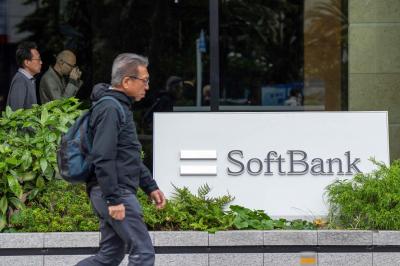By the middle of last month, John Lyotier’s travel software business Left Technologies Inc was cratering with the spread of the COVID-19 pandemic. Seeking to cut costs, he reached out to his office landlord, who offered rent relief.
Then he contacted Amazon.com Inc, asking to “explore creative financing opportunities” for his monthly cloud-computing bill.
The response was succinct: “Nope, that’s the way it is.”
The ability to rent computing power online has revolutionized the Internet economy and turned a trio of companies — Amazon, Microsoft Corp and Alphabet Inc’s Google — into the indispensable utilities of the Web.
The trio was expected to generate annual cloud revenue of more than US$60 billion — before greater demand from stay-at-home orders turned the cloud businesses into one of the bright spots in the collapsing US economy.
With the economic devastation of COVID-19, entrepreneurs such as Lyotier feel that the fate of their businesses rests on the benevolence of their cloud provider.
While Amazon Web Services (AWS) is restructuring some large contracts on a case-by-case basis, according to a person familiar with the decisions, smaller companies are not receiving the same flexibility.
Half a dozen start-up executives said that recent appeals to these cloud companies have gone unanswered.
While older technology providers, such as Cisco Systems Inc, are offering credits to customers, the major cloud companies have not made any public announcements about deferring or cutting bills for clients.
“They’ve been pretty radio silent,” said Jason Kim, cofounder of Taloflow, which advises businesses on managing AWS bills.
Cloud providers attracted so many companies over the past decade, in part, with the flexibility of the model. Businesses can start with a credit card, often on a pay-for-what-you-use basis, rather than pay for a back-room server or mainframe computer. Demand drops, and, typically, so does cloud usage and the bill.
However, the sales strategy for the big cloud companies has been to ink long-term deals. Customers typically receive discounts on list prices in exchange for minimum spending thresholds.
As of the end of December last year, AWS recorded US$29.8 billion it expected to post as future revenue as part of such contracts that run more than one year. Google told investors at the end of last year that it had US$11.4 billion in cloud sales it planned to book. Microsoft sells cloud services, as well as much of its on-premise software, via multiyear agreements.
Start-ups and other companies locked into these contracts feel particularity hurt.
“Their revenues have sunk 50 percent or 60 percent, but their costs have remained static,” Kim said.
Regulated utilities have offered some relief. California state regulators, for example, prohibited utility providers from shutting off power for missed payments.
When a California company asked Google for payment assistance, it was told the company could only suspend their account and reopen it 30 days later, according to an April 1 e-mail viewed by Bloomberg News.
“We treat payment terms with our customers or partners as confidential and we’re not able to disclose details,” a Google Cloud spokesperson said in a statement.
An AWS spokesman said customers can turn off cloud services in a way that would not be possible with corporate-owned data centers.
“This is a very difficult time for some of our customers, and we are actively working across a number of dimensions to help them manage costs,” he said.
Microsoft and Google have given some customers more time to pay bills, the Information reported earlier.
Economic data from some smaller enterprise firms give a snapshot of the downturn’s impact on cloud computing.
GloboTech Communications, a Montreal company that provides server and data management services, said that about 7 percent of clients reported issues paying their bill this month.
Chief executive officer Pierre-Luc Quimper expected the number to increase and said that the company has accommodated a vast majority with deferred or staggered payments.
“The Internet is an infrastructure that’s become essential to our lives,” he said. “We’re not interested in putting companies out of business just because they’re not paying for a month.”

Japanese technology giant Softbank Group Corp said Tuesday it has sold its stake in Nvidia Corp, raising US$5.8 billion to pour into other investments. It also reported its profit nearly tripled in the first half of this fiscal year from a year earlier. Tokyo-based Softbank said it sold the stake in Silicon Vally-based Nvidia last month, a move that reflects its shift in focus to OpenAI, owner of the artificial intelligence (AI) chatbot ChatGPT. Softbank reported its profit in the April-to-September period soared to about 2.5 trillion yen (about US$13 billion). Its sales for the six month period rose 7.7 percent year-on-year

CRESTING WAVE: Companies are still buying in, but the shivers in the market could be the first signs that the AI wave has peaked and the collapse is upon the world Taiwan Semiconductor Manufacturing Co (TSMC, 台積電) yesterday reported a new monthly record of NT$367.47 billion (US$11.85 billion) in consolidated sales for last month thanks to global demand for artificial intelligence (AI) applications. Last month’s figure represented 16.9 percent annual growth, the slowest pace since February last year. On a monthly basis, sales rose 11 percent. Cumulative sales in the first 10 months of the year grew 33.8 percent year-on-year to NT$3.13 trillion, a record for the same period in the company’s history. However, the slowing growth in monthly sales last month highlights uncertainty over the sustainability of the AI boom even as

AI BOOST: Next year, the cloud and networking product business is expected to remain a key revenue pillar for the company, Hon Hai chairman Young Liu said Manufacturing giant Hon Hai Precision Industry Co (鴻海精密) yesterday posted its best third-quarter profit in the company’s history, backed by strong demand for artificial intelligence (AI) servers. Net profit expanded 17 percent annually to NT$57.67 billion (US$1.86 billion) from NT$44.36 billion, the company said. On a quarterly basis, net profit soared 30 percent from NT$44.36 billion, it said. Hon Hai, which is Apple Inc’s primary iPhone assembler and makes servers powered by Nvidia Corp’s AI accelerators, said earnings per share expanded to NT$4.15 from NT$3.55 a year earlier and NT$3.19 in the second quarter. Gross margin improved to 6.35 percent,

FAULTs BELOW: Asia is particularly susceptible to anything unfortunate happening to the AI industry, with tech companies hugely responsible for its market strength The sudden slump in Asia’s technology shares last week has jolted investors, serving as a stark reminder that the world-beating rally in artificial intelligence (AI) and semiconductor stocks might be nearing a short-term crest. The region’s sharpest decline since April — triggered by a tech-led sell-off on Wall Street — has refocused attention on cracks beneath the surface: the rally’s narrow breadth, heavy reliance on retail traders, and growing uncertainty around the timing of US Federal Reserve interest-rate cuts. Last week’s “sell-off is a reminder that Asia’s market structure is just more vulnerable,” Saxo Markets chief investment strategist Charu Chanana said in